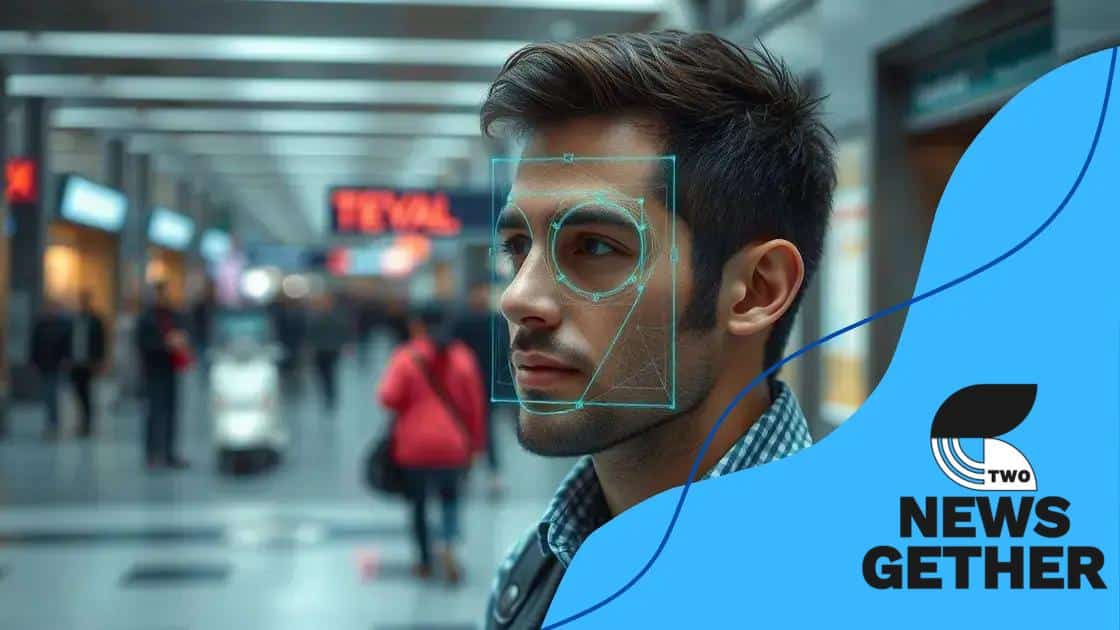Privacy concerns around AI-driven facial recognition systems

Privacy concerns around AI-driven facial recognition systems include unauthorized data collection, potential misuse of personal information, and the need for regulatory frameworks to protect individual rights.
Privacy concerns around AI-driven facial recognition systems have sparked vital discussions about ethics and data security. Have you thought about how these technologies impact our daily lives and rights? Let’s explore this intriguing topic.
Understanding facial recognition technology
Understanding facial recognition technology is crucial in today’s world. This advanced system analyzes facial features to identify individuals. But how does it actually work?
Facial recognition technology uses algorithms to compare images of faces. It captures key characteristics and matches them against a database. The process can happen in seconds, making it quick and efficient. However, this raises many questions about privacy and ethics.
How Facial Recognition Works
The technology relies on various algorithms to map facial features. It detects points like the distance between eyes and the shape of the jawline. By creating a unique mathematical representation of a face, it can authenticate identities accurately.
- Facial landmarks: Key positions such as the eyes, nose, and mouth.
- Distance measurement: Analyzing space between features to create a facial signature.
- Machine learning: Continuously improving accuracy through training with data.
Despite its benefits, the use of facial recognition technology presents privacy concerns. Many worry about how data is collected and stored. Unauthorized access or misuse can lead to breaches of personal security.
Applications of Facial Recognition
This technology finds applications in various fields. For instance, law enforcement agencies use it to identify suspects quickly. In retail, businesses track customer behavior for improved services. Even smartphones employ this feature for user authentication.
- Security surveillance: Monitoring public areas for enhanced safety.
- Social media tagging: Automatically recognizing friends in photos.
- Access control: Restricting entry to authorized personnel only.
As we navigate these advancements, the importance of ethical practices cannot be overlooked. Everyone should understand their rights to privacy. Continuous dialogue about regulations can help balance progress and security.
Key privacy challenges
Key privacy challenges surrounding facial recognition technology are complex and multifaceted. As this technology becomes more prevalent, understanding these challenges is vital for everyone.
One major issue is data security. When users’ images are stored in databases, they may be at risk of being hacked or misused. This can lead to unauthorized access and serious breaches of privacy. Therefore, maintaining a strong cybersecurity framework is essential.
Consent and Transparency
Another challenge is obtaining user consent. Many people are unaware that their images are being collected and used. Transparency is crucial; organizations must clearly communicate how and why data is collected.
- Clear privacy policies: Users should be informed in simple language.
- Opt-in systems: Individuals should have the choice to consent.
- Accountability: Companies must be held responsible for data misuse.
Moreover, the potential for bias within facial recognition systems cannot be ignored. Studies have shown that these technologies can be less accurate for people of color and women. Such biases can result in unfair treatment and discrimination, further exacerbating privacy concerns.
Regulatory Oversight
Regulatory measures are desperately needed to address these challenges. Laws can help protect individuals from the misuse of their data. Governments around the world are starting to recognize this need.
- Establishing guidelines: Governments should set standards for acquiring and using facial recognition data.
- Regular audits: Companies must undergo evaluations to ensure compliance with privacy regulations.
- Public awareness: Educating the public about their rights can empower better decision-making.
With the rapid growth of technology, balancing innovation and privacy is essential. As society moves forward, addressing these key challenges will shape the future of facial recognition technology.
Real-world implications of data misuse

Real-world implications of data misuse in facial recognition technology can have serious consequences for individuals and society. When personal data is mishandled, it not only violates privacy but can also lead to unintended harm.
For instance, if a person’s facial data is stolen, it can be used for identity theft. Thieves can impersonate someone, accessing accounts and finances. This breach of trust can lead to devastating outcomes for victims, including financial loss and emotional distress.
Impact on Civil Liberties
Misuse of facial recognition technology can also threaten civil liberties. Surveillance systems may be employed unfairly, targeting specific groups of people. This can lead to a chilling effect on freedom of expression, making individuals hesitant to speak out or participate in public life.
- Targeted monitoring: Certain communities may experience increased scrutiny.
- Suppression of dissent: Activists might be deterred from protesting.
- Discriminatory practices: Biased practices can perpetuate inequality.
Furthermore, data misuse can foster a lack of trust between the public and authorities. When people see their data being abused, they may become suspicious of law enforcement and government actions. This distrust can hinder cooperation and community safety efforts.
Long-Term Consequences
The long-term consequences of data misuse extend beyond immediate harm. As trust erodes, individuals may become less likely to share information, even for beneficial purposes. This can undermine efforts to enhance public safety through technology.
- Reduced participation in community programs.
- Lower engagement in civic responsibilities.
- Increased isolation for marginalized groups.
Addressing these implications requires a collective effort. Ensuring that facial recognition data is used responsibly is crucial for preserving individual rights and building a safe, trusting society.
Regulatory frameworks and responses
Regulatory frameworks and responses to facial recognition technology are essential to ensure privacy and security. As this technology advances, many governments recognize the need for guidelines to protect individual rights.
Some countries have begun to implement laws that govern how facial recognition data can be collected and used. These laws aim to increase transparency and accountability for organizations that utilize this technology.
Current Regulations
In various regions, regulations are emerging to address privacy concerns directly. For instance, the European Union has established the General Data Protection Regulation (GDPR), which provides strict rules for data handling.
- Consent: Organizations must obtain explicit permission before processing personal data.
- Data protection: Companies are required to implement security measures to protect user data.
- Right to access: Individuals can request information on how their data is used.
Other places, like California, have introduced specific bills that focus on facial recognition technology, reflecting growing awareness of its implications. These laws not only protect users but also hold companies accountable for violations.
Challenges in Implementation
Despite these efforts, challenges remain in enforcing regulations effectively. One major obstacle is the rapid pace of technological development. Regulations often lag behind advancements in facial recognition technology, making it difficult to ensure that laws remain relevant.
- Adapting to new technology: Regulators must continuously revise guidelines.
- Varying standards: Different regions may have inconsistent rules, confusing organizations.
- Resource limitations: Regulatory bodies might lack the funding or staff needed for proper oversight.
Furthermore, there is a constant debate about finding the right balance between innovation and privacy. Striking this balance is crucial to fostering a safe environment while allowing technological growth.
Future of AI in facial recognition
Future of AI in facial recognition technology is bright yet filled with challenges. As advancements continue, we can expect significant developments in how facial recognition is used across various sectors.
One major trend is the enhancement of accuracy. With improvements in machine learning algorithms, facial recognition systems are becoming more reliable. This increased accuracy not only helps in security applications but also enhances user experiences in consumer products.
Integration with Other Technologies
Facial recognition will likely integrate with various technologies. For example, combining it with artificial intelligence and big data analytics can improve decision-making processes. This integration can lead to new solutions in sectors like healthcare, where accurate patient identification is vital.
- Smart homes: Facial recognition can provide secure access and personalized experiences.
- Retail: Businesses can analyze customer behavior to tailor services.
- Transportation: Enhanced security through identification in public transport systems.
Despite these benefits, ethical considerations remain crucial. The debate over privacy and consent will likely intensify as more data is collected. Ensuring that individuals understand how their data is used will be essential for public trust in this technology.
Regulatory Changes
In the future, we can also anticipate regulatory changes as governments respond to the growing use of facial recognition. Policies may evolve to enforce stricter guidelines on data usage, ensuring that user rights are protected.
- Transparency: Companies must disclose data use practices.
- Accountability: Enforcement of penalties for data misuse.
- Public dialogue: Engaging with communities to address concerns about safety and privacy.
As advancements in AI continue, the future of facial recognition technology promises innovation alongside necessary safeguards. Balancing technological growth with ethical responsibility will help build a better future.
Conclusion: Facial recognition technology has the potential to greatly enhance security and personalization in our daily lives. However, it also raises significant privacy concerns that need to be addressed. As AI continues to evolve, finding the right balance between utilizing this technology and ensuring individual rights is essential. Regulation, transparency, and ethical considerations will be key in shaping the future of facial recognition. Engaging in public dialogue will help build trust and ensure that technology serves society positively.
FAQ – Frequently Asked Questions about Facial Recognition Technology
What are the main privacy concerns associated with facial recognition?
The main privacy concerns include unauthorized data collection, potential misuse of personal information, and lack of transparency regarding how data is used.
How is facial recognition technology regulated?
Facial recognition technology is regulated through laws that require transparency, user consent, and data protection measures to ensure individual rights are upheld.
What are the future trends in facial recognition technology?
Future trends include improved accuracy through AI advancements, integration with smart devices, and the need for ongoing ethical discussions surrounding privacy.
How can organizations build trust when using facial recognition?
Organizations can build trust by engaging with the community, being transparent about data usage, and ensuring compliance with regulations to protect user privacy.






